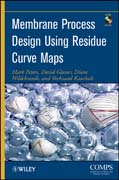
Membrane process design using residue curve maps
Peters, Mark
Glasser, David
Hildebrandt, Diane
INDICE: About the Authors. Preface. Acknowledgments. Notation. Chapter 1: Introduction. Chapter 2: Permeation Modeling. 2.1 Diffusion Membranes. 2.2 Membrane Classification. Chapter 3: Introduction to Graphical Techniques in Membrane Processes. 3.1 A thought experiment. 3.2 Binary Separations. 3.3 Multi-Component Systems. Chapter 4: Properties of Membrane Residue Curve Maps. 4.1 Stationary Points. 4.2 Membrane Vector Field. 4.3 Uni-distribution Lines. 4.4 The effect of -values on the topology of M-RCMs. 4.5 Properties of an Existing Selective M-RCM. 4.6 Concluding Remarks. Chapter 5: Application of Membrane Residue Curve Maps to Batch and Continuous Processes. 5.1 Introduction. 5.2 Review of previous chapters. 5.3 Batch Membrane Operation. 5.4 Permeation Time. 5.5 Continuous Membrane Operation. 5.6 Conclusion. Chapter 6: Column Profiles for Membrane Column Sections. 6.1 Introduction to Membrane Column Development. 6.2 Generalised Column Sections. 6.3 Theory. 6.4 Column Section Profiles: OperatingCondition 1. 6.5 Column Section Profiles: Operating Condition 2. 6.6 Column Section Profiles: Operating Condition 3 & 4. 6.7 Applications and Conclusion. Chapter 7: Novel Graphical Design Methods for Complex Membrane Configurations. 7.1 Introduction. 7.2 Column Sections. 7.3 Complex Membrane Configuration Designs: General. 7.4 Complex Membrane Configuration Designs: Operating Condition 1. 7.5 Complex Membrane Configuration Designs: Operating Condition 2. 7.6 Complex Membrane Configurations: Comparison with Distillation Systems. 7.7 Hybrid Distillation-Membrane Design. 7.8 Conclusion. Chapter 8: Synthesis and Design of Hybrid Distillation-Membrane Processes. 8.1 Introduction. 8.2 Methanol/Butene/MTBE System. 8.3 Synthesis of a Hybrid Configuration. 8.4 Design of a hybrid configuration. 8.5 Conclusion. Chapter 9: Concluding Remarks. 9.1 Conclusions. 9.2 Recommendations and future work. 9.3 Design considerations. 9.4 Challenges for membrane process engineering. References. Appendix A: MemWorX User Manual. A.1 System requirements. A.2 Installation. A.3 Layout of MemWorX. A.4 Appearance of Plots. A.5 Step by step guide to plot using MemWorX. A.6 Tutorial Solutions. Appendix B: Flux Model for PERVAP 1137 Membrane. Appendix C: Proof of Equation for Determining Permeation Time in a Batch Process. Appendix D: Proof of Equation for Determining Permeation Area in a Continuous Process. Appendix E: Proof of the Difference Point Equation. E.1 Proof (using analogous method to distillation). E.2 Proof (using mass transfer). Index.
- ISBN: 978-0-470-52431-2
- Editorial: John Wiley & Sons
- Encuadernacion: Cartoné
- Páginas: 240
- Fecha Publicación: 28/01/2011
- Nº Volúmenes: 1
- Idioma: Inglés
